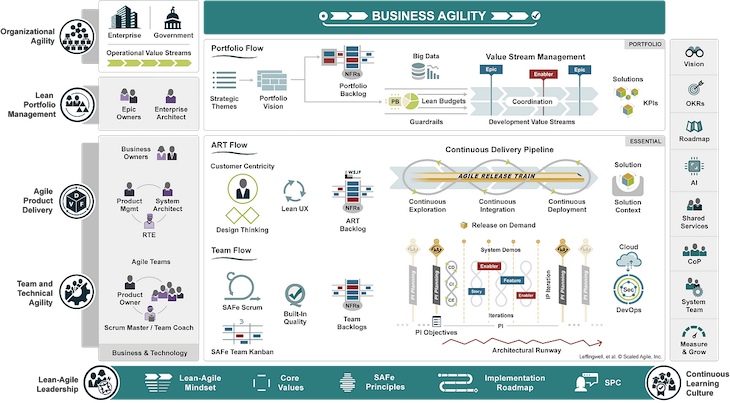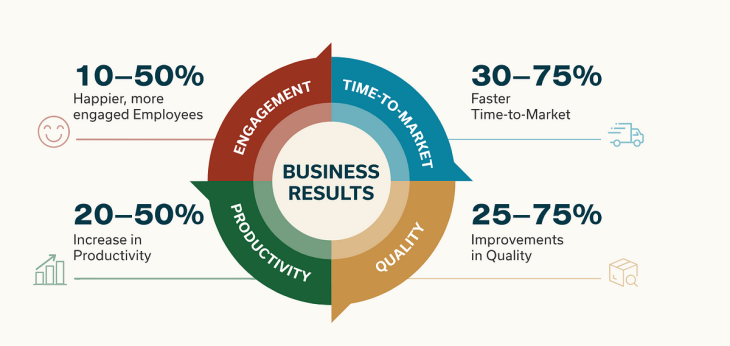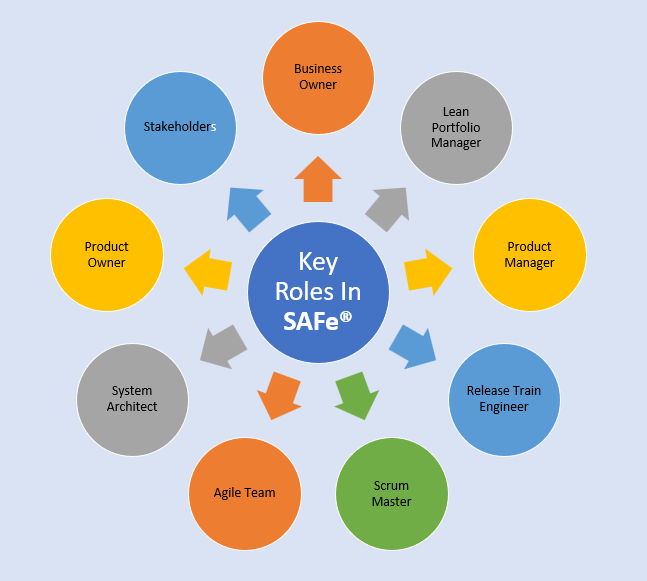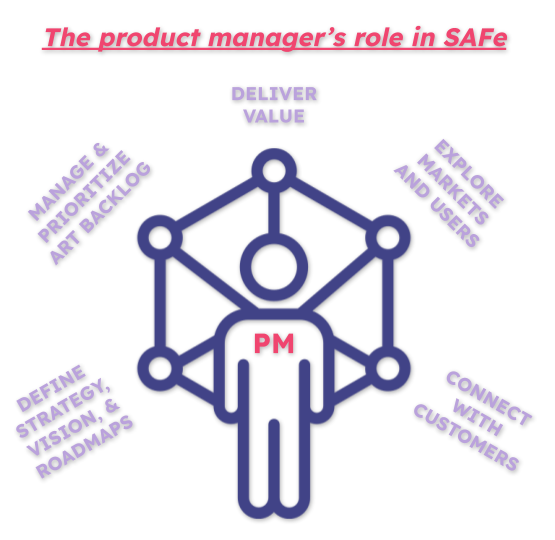The Scaled Agile Framework (SAFe) is a methodology that applies agile principles to large organizations and complex projects. Its purpose is to ensure the coordination and scaling of agile practices across multiple teams collaborating to create a product or solution.

In this comprehensive guide, we’ll unpack the fundamental ideas behind SAFe and explore how it enables enterprises to achieve business agility — i.e., the ability to promptly respond to market demands, frequently launch, swiftly react, and much more.
The concept of SAFe was introduced in 2011 by software development methodologist Dean Leffingwell, who recognized the challenges, overhead, and complexity involved in implementing agile for large teams.
To meet the requirements of large enterprises, Leffingwell introduced the concept of scaled agile practices. This methodology provides a structured approach to planning, executing, and measuring the progress of large-scale agile initiatives.
The SAFe Framework provides various layers, roles, portfolios, value streams, programs, and practices tailored to each layer while maintaining alignment between goals and objectives.
SAFe endorses agile practices such as scrum, kanban, and extreme programming (XP), which help organizations achieve faster time-to-market, quality, continuous effective integration, deployment (CI/CD), customer satisfaction, and quick turnaround on market conditions.
SAFe is made up of three primary levels:

The benefits associated with the Scaled Agile Framework are numerous, and official data shows that SAFe creates value for more than 20,000 companies and 10,000 individuals worldwide:

Some of the most significant benefits include:
To understand the SAFe framework properly, it’s essential to comprehend the value of each element. The framework facilitates the transfer of value throughout an organization’s hierarchy and functions.
Some crucial elements to focus on when practicing SAFe include:
In SAFe, each individual has well-defined roles and responsibilities to facilitate the implementation and execution of processes within the framework:

Some primary key roles include:
The above roles can vary and be tailored according to an organization’s structure.
Product managers play a crucial role within the SAFe framework. They are responsible for turning ideas into innovative solutions and collaborating effectively with various departments in the organization.
Collaboration is key, and experienced product managers working within a Scaled Agile Framework often find themselves working alongside RTEs, system architects, business owners, and customers to ensure smooth product development.
Furthermore, PMs act as a central source of information for product owners (POs) and agile teams building product features and improvements.
The SAFe framework defines the product manager’s responsibilities, which can be categorized into five main areas. These areas are equally valuable and consistent with other common methodologies and product management practices:

Organizations across various industries have adopted the Scaled Agile Framework (SAFe) to boost collaboration, efficiency, and customer satisfaction. In this section, we’ll explore some real-world examples of SAFe success stories from diverse sectors such as IT services, software development, energy, national security, logistics, fintech, and music streaming:
NTT Data’s adoption of SAFe led to a significant enhancement in its software development process. By incorporating the Agile Release Train (ART) concept, NTT Data was able to synchronize multiple teams working on different aspects of projects. This improved alignment and collaboration resulted in a significant reduction in time-to-market for new products and features. The company also reported increased employee engagement and better overall product quality, contributing to higher customer satisfaction rates.
The implementation of SAFe at Nokia Software allowed the company to address complex customer requirements more effectively by introducing a lean portfolio management approach. This enabled it to prioritize initiatives based on value delivery, reducing waste and improving resource allocation. As a result, Nokia Software saw an increase in project success rates and experienced a meaningful reduction in time-to-market for new products while maintaining high-quality standards.
Chevron’s adoption of SAFe principles led to the establishment of cross-functional agile teams that focused on delivering value incrementally through iterative development cycles. This approach fostered greater transparency, faster decision-making processes, and more effective risk management strategies. Chevron managed to boost project completion rates as well as employee engagement and job satisfaction by embracing SAFe methodologies in its organization.
By utilizing the Scaled Agile Framework, the United States Air Force revamped its software development practices for greater efficiency within its Kessel Run program, an initiative aimed at rapidly delivering combat capabilities through innovative software solutions.
The adoption of SAFe principles enabled faster deployment cycles (from years down to months), streamlined communication among stakeholders, and expedited project delivery timelines — all leading to improved mission readiness for national security purposes.
Embracing SAFe allowed FedEx to optimize its operations while enhancing customer satisfaction across its global shipping network. By adopting the SAFe principle of “built-in quality,” FedEx improved its software development process, reducing defects and decreasing lead times for new features. The framework also fostered a culture of continuous improvement, enabling FedEx to adapt quickly to changing market conditions and maintain a competitive edge.
To remain competitive in the fast-paced fintech industry, American Express turned to SAFe for guidance on streamlining its business strategy with evolving customer needs. By implementing the agile release train concept and establishing cross-functional teams focused on delivering value incrementally, American Express was able to reduce time-to-market for new products while maintaining high quality standards. This increased product quality led to higher customer satisfaction rates.
In the highly competitive music streaming industry, Spotify recognized the need for agility to stay ahead of the curve. Though its model for scaling agile differs somewhat from SAFe (and is no longer in use at the organization today), embracing SAFe principles enabled Spotify to foster a culture of continuous improvement through inspect-and-adapt feedback loops and iterative development cycles. As a result, the streaming giant was able to rapidly respond to changing market conditions and user preferences, leading not only to an increase in active users, but also contributing significantly toward maintaining a loyal user base.
Product managers looking to enhance their skills and demonstrate their expertise in implementing SAFe practices can pursue various certifications offered by Scaled Agile Inc. These certifications not only validate a PM’s knowledge of SAFe principles but also showcase their commitment to continuous learning and improvement.
The SAFe® Product Manager/Product Owner (POPM) certification is specifically designed for product managers, product owners, business analysts, and other professionals responsible for defining, prioritizing, and validating requirements within an organization. This certification focuses on the roles of both the product manager (responsible for strategic planning and decision-making) and the product owner (responsible for tactical execution).
By obtaining the POPM certification, individuals gain a comprehensive understanding of how to effectively apply lean agile principles in managing products throughout their lifecycle. They learn how to develop customer-centric solutions using design thinking techniques while working closely with cross-functional teams within an ART.
Additionally, they are equipped with tools to prioritize features based on value delivery and continuously improve processes through inspect-and-adapt feedback loops.
While the POPM certification is the most directly applicable SAFe certification for product managers seeking expertise in SAFe implementation, there are other relevant programs that can further expand your knowledge:
Pursuing these certifications can help product managers broaden their skillset, showcase their expertise in implementing SAFe practices, and increase their value to both current and prospective employers.
Overall, SAFe’s product management practices provide an efficient framework for collaborative, customer-focused, and value-driven agile organizations on a large scale. These practices facilitate the creation of products that meet customer demands, align with strategic objectives, and stay competitive in the ever-changing market.
SAFe also inculcates a lean agile mindset among product management teams, emphasizing continuous learning, experimentation, and the ability to pivot based on validated learning. The framework encourages PMs to engage in iterative development, frequent feedback, and adaptation based on changing market dynamics.
By adopting SAFe practices, organizations can enhance their ability to deliver products that meet customer needs, align with strategic goals, and remain competitive in a rapidly evolving market.
Featured image source: IconScout

LogRocket identifies friction points in the user experience so you can make informed decisions about product and design changes that must happen to hit your goals.
With LogRocket, you can understand the scope of the issues affecting your product and prioritize the changes that need to be made. LogRocket simplifies workflows by allowing Engineering, Product, UX, and Design teams to work from the same data as you, eliminating any confusion about what needs to be done.
Get your teams on the same page — try LogRocket today.

A practical framework for PMs to use AI in ideation without sacrificing judgment, strategy, or decision quality.

A practical five minute revenue estimation method to help product managers compare ideas, drop low impact features, and prioritize smarter.

A practical guide for PMs who want to stop being bottlenecks, delegate smarter, and lead teams effectively with a clear ownership framework.

Stop letting unreliable data block features. Treat data as inventory to track quality, ownership, and ship with confidence.